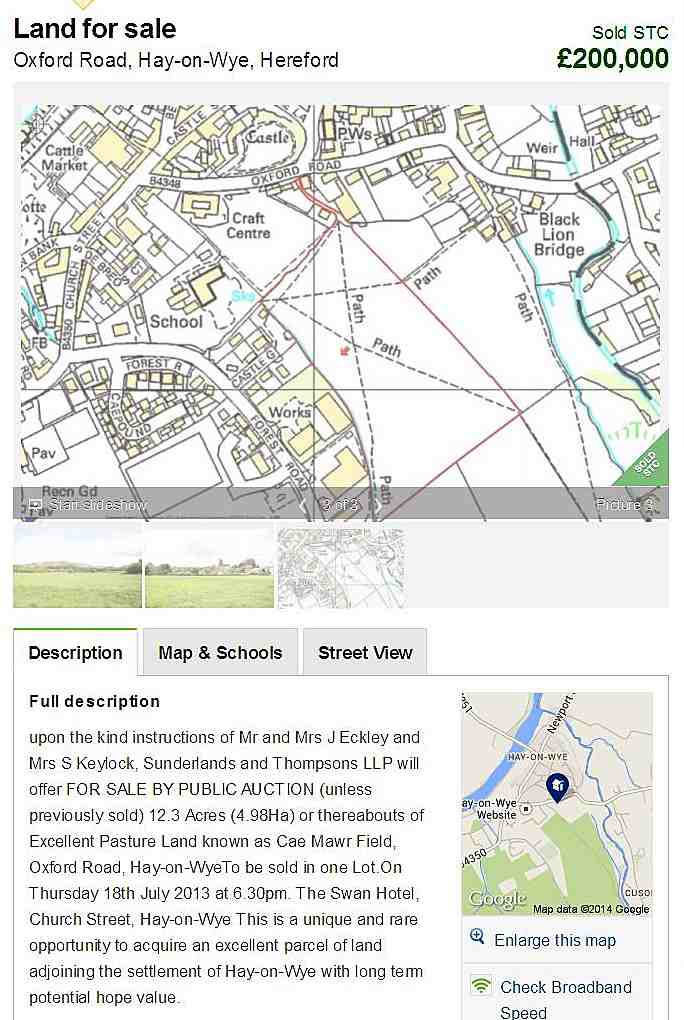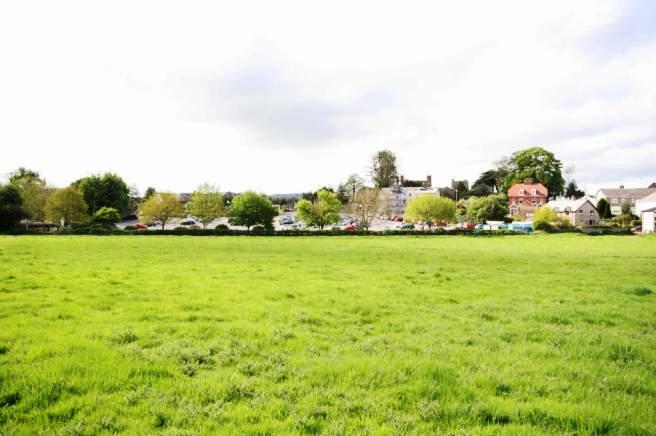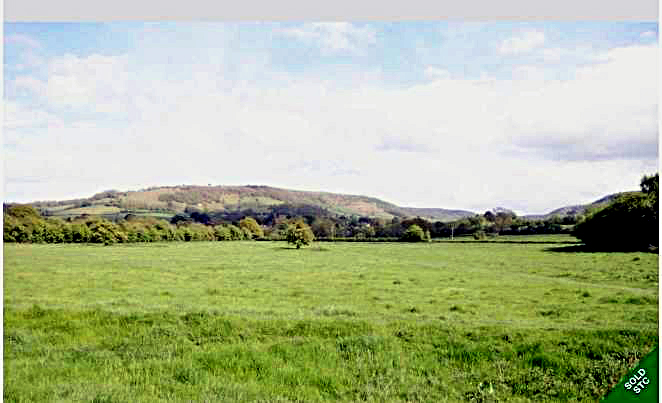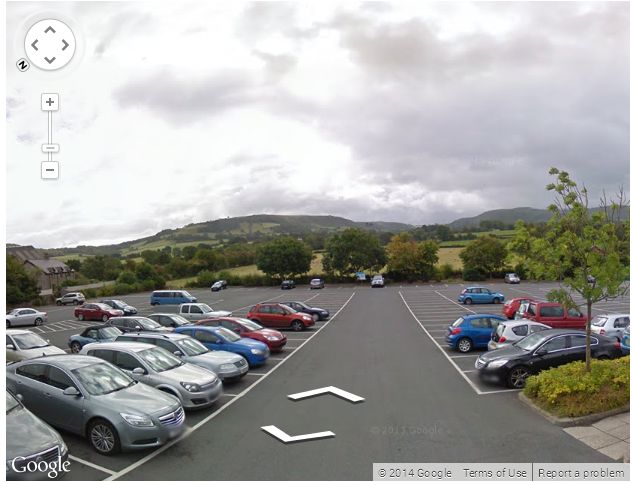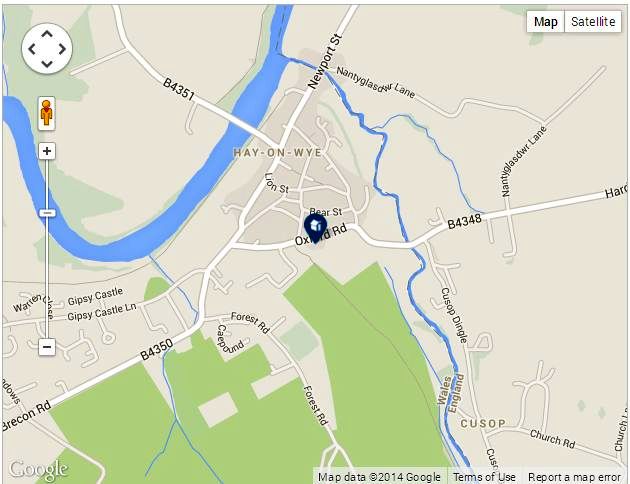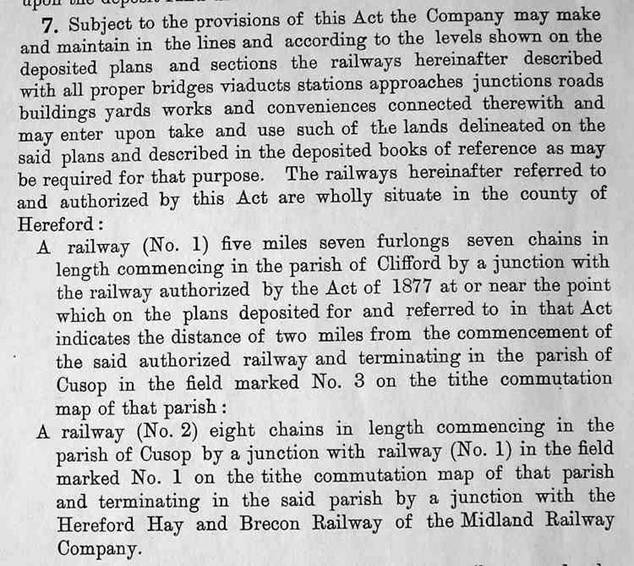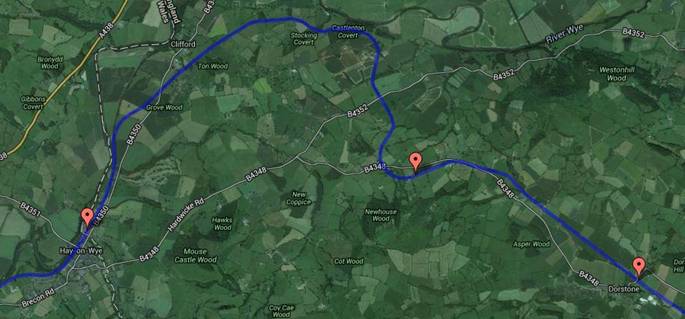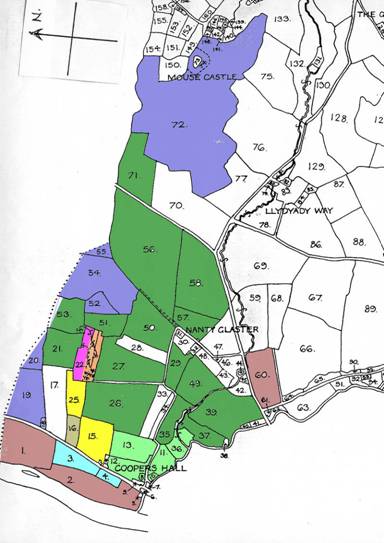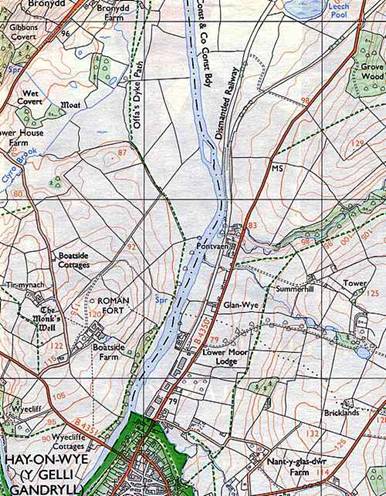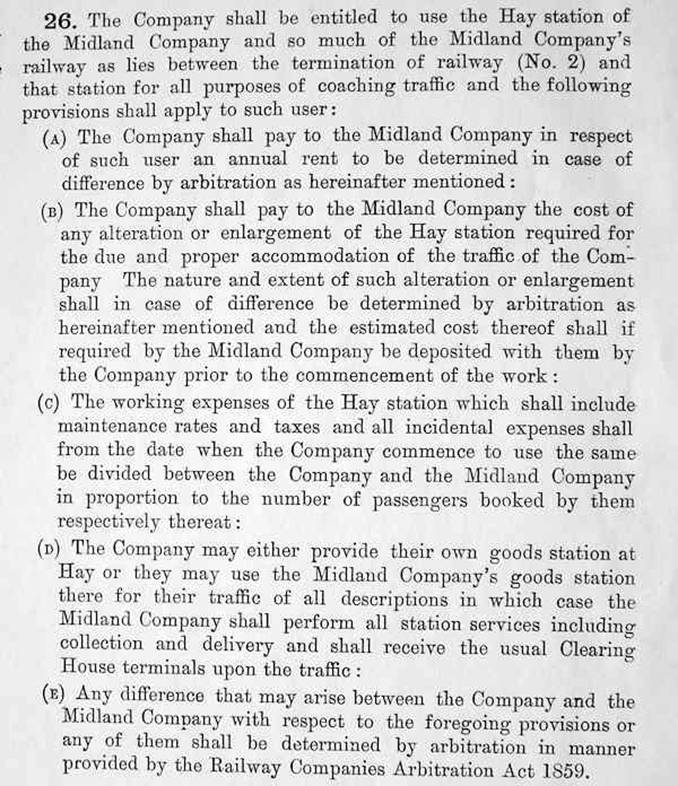Title: | Cae Mawr: The Station that Never Was - The Hay terminus of the Golden Valley Railway |
Date: | 1876 - 1884 |
Cae Mawr: The Station that Never Was -
The Hay Terminus of the Golden Valley Railway
By Bob Steele
Introduction
In 1876 an Act of Parliament was passed authorising the construction of a railway through the Golden Valley from a junction with the Great Western Railway at Pontrilas to a terminus at Dorstone. The 1877 ‘Golden Valley Railway – Extension to Hay’ Act proposed to extend the line from Dorstone and create a new stand-alone terminus station at Hay on Wye. The exact location of this Hay terminus and the planned route to it from Dorstone are now somewhat obscure because the plans subsequently changed; the original track of the railway extension from Dorstone and the intended new station at Hay were never built. They were superseded by a more ambitious proposal in the Hay Extension Act of 1884 to complete a link to the Midland Railway Company’s existing station at Hay on Wye instead, thus providing a through route at the northern end of the Golden Valley to a wide range of destinations in the Midlands and North of England. This was the line that was eventually built, involving a longer, more difficult and substantially more expensive route from Dorstone to a junction with the Midland Railway line north of Hay.
It is however of interest to examine the reasoning behind the initial proposal to build an independent railway station in Hay, its intended location, the justification for the subsequent abandonment of the original plans, and the consequences of the decision to do so.
The initial proposal for the Hay extension
A newspaper cutting from the Cardiff Times dated 28 October 1876 reported a meeting of the Directors of the Golden Valley Railway Company to receive a deputation advocating extension of the proposed Pontrilas to Dorstone railway onwards to Hay on Wye. According to this contemporary press report it was resolved at the meeting [subject to various financial considerations] to extend the line to Caemawr in the parish of Hay, independently of the Midland Railway which already had a station at Hay on its established Hereford and Brecon line.
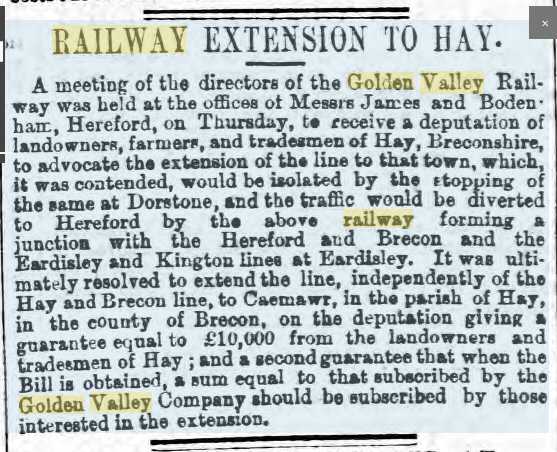
As can be inferred from the press report, the main underlying motivation of the landowners, farmers and tradesmen of Hay at this time was to avoid business being diverted away from Hay by the new railway. At the time it was logical to suppose that a railway at Dorstone would draw trade in the Golden Valley away from Hay and south to Hereford and Abergavenny via the Great Western Railway junction at Pontrilas. Indeed, creating and profiting from such trade flows was one of the key planks in the prospectus to the original investors in the railway. There was also talk at the time of extending the Golden Valley line north to Eardisley for an additional link to Hereford via the Midland Railway there, and this possibility posed an even clearer threat to Hay and its market. In this context the Hay delegation’s interests were clearly best served by proposing to bring the railway from Dorstone to Hay via the cheapest and most direct route without further improving access from the Golden Valley to Hereford.
The lie of the land meant that the easiest route from Dorstone would bring the line into Hay to the south of the town, through Cusop. This put the town of Hay between the new line and the existing Midland Railway station, making a through link there to Hereford and other destinations impractical and requiring an independent Hay terminus station on the Golden Valley line. Both of these outcomes were in line with the Hay investors’ short-term objectives. It was, however, a proposition with wider implications for the prosperity of the railway, as it closed off any opportunity for carrying profitable through traffic of passengers and freight from the Midland Railway. This conflict of interests was destined to cause significant strife between the Directors and Shareholders of the Golden Valley Railway Company in years to come.
In any event, the Hay investors carried the initial argument and the location of the planned independent Hay terminus at Cae Mawr, as reported in 1876, was confirmed in the plans associated with the 1877 Parliamentary Act authorising the railway extension. A newspaper cutting from the Cardiff Times of 8th September 1877 reports the ceremony of cutting the first sod of the Hay extension to the Golden Valley Railway at the Cae Mawr field in Hay parish. The ceremony was performed by Mrs De Winton in the presence of “an immense concourse of people” after a procession involving several bands and a variety of local organisations and dignitaries including the Mayors of Hereford and Brecon, Mr RGL Robinson, Chairman of the Board of Directors of the Golden Valley Railway Company, Sir Joseph Bailey, Bart., MP, the Reverend Ll Bevan, Mr Arthur Cheese and Mr Bodenham. Lunch was served for 300 in a marquee on the site and the schoolchildren of the town were given tea and cake.
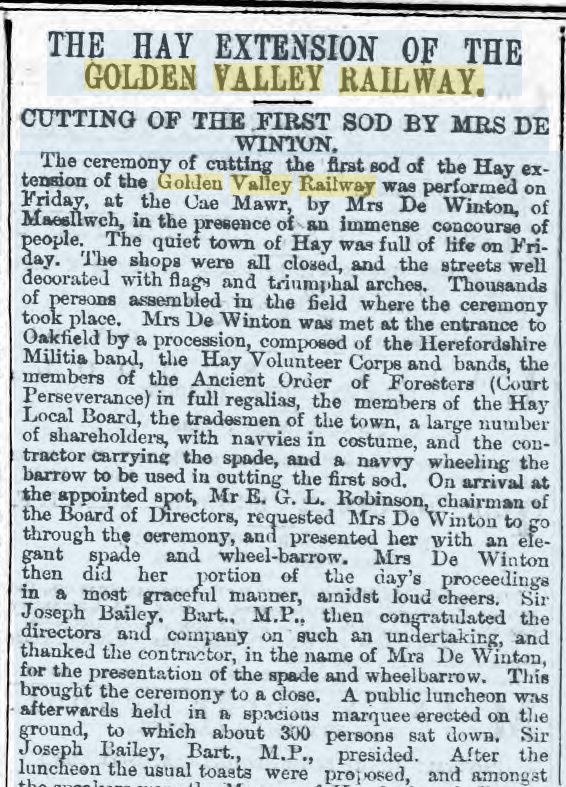
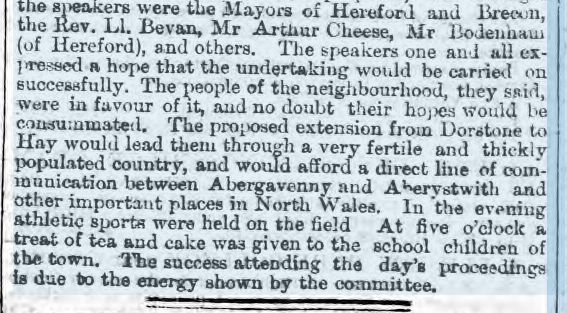
Location of the planned Golden Valley Railway terminus at Cae Mawr
So where exactly was the Cae Mawr terminus of the Golden Valley Railway? Fortunately, the field has retained its name to the present day, so its location can be pinpointed. On 18th July 2013, 12.3 acres of excellent pasture land known as Cae Mawr field was offered for sale by public auction at the Swan Hotel in Hay on Wye. The details provided by the agents, Sunderlands and Thompsons of Hay, are on the internet and extracts of the particulars and accompanying maps and photographs are shown below. No mention is made in the sale particulars of the significance of Cae Mawr in the history of the Golden Valley Railway, although this is perhaps excusable since, as discussed later, the planned station and other developments there never materialised.
|
|
|
Agent’s sale particulars and location maps of Cae Mawr Field, Oxford Road, Hay on Wye
|
The scars from the “first sod” so enthusiastically and ceremoniously cut in front of excited crowds back in 1877 have long since been healed by nature, but somewhere in Cae Mawr field, photographed below, is where the crowds cheered and the bands played in celebration of the dawning – as they thought - of a new railway age for Hay.
|
|
| Looking towards Hay from Cae Mawr Field. The municipal car park is in the middle ground with Hay Castle behind
|
The terminus of the Golden Valley Railway with its accompanying station and goods yard would have been in the foreground of the picture of Cae Mawr below, with the proposed railway line from Dorstone approaching from the east through the hills in the background. The exact location of the planned track and buildings is a matter of conjecture unless the original plan documents that accompanied the 1877 Act come to light.
|
|
| View east from Hay across Cae Mawr Field looking towards Dorstone
|
A wider view of the area, below, courtesy of Google Earth, shows that what is now the main public car park in Hay leads down to Cae Mawr field. There is a certain irony that this space now dedicated to cars might easily have been the forecourt to the Golden Valley Railway station and goods yards instead.
|
|
| Cae Mawr Field lies behind the trees at the bottom of the public car park in Hay
|
A somewhat broader scale map of Hay, also courtesy of Google, helps bring the physical layout into perspective.
|
|
| Enlarged map of Hay on Wye The marker points to Cae Mawr field to the south of Oxford Road
|
This map shows clearly how bringing the Golden Valley Railway from Dorstone to a terminus station at Cae Mawr, south of the town of Hay, meant that a link to the Midland Railway line – which ran along the bank of the River Wye – was impossible, because the town stood between the two. Part of the route of the old Midland Railway Hereford, Hay and Brecon line is now a footpath along the bank of the Wye, and is shown on the map. The Hay Midland station, sidings and goods yard were located to the north-east of the Wye Bridge close to the eastern bank of the river, roughly where the marked footpath ends close to Newport Street – an area now occupied by commercial premises.
Abandonment of the original plans at Cae Mawr
There are no traces of the railway or a station to be found at Cae Mawr today, since as things turned out the plans to build them there never reached fruition. Perhaps if they had, the story of the Golden Valley Railway Company detailed elsewhere on this website might have had a happier ending; the cost of the line that was eventually built was substantially greater than that envisaged for the original extension and the additional expense played a significant part in the seemingly insoluble financial troubles of the company and its eventual bankruptcy.
The sums of money involved were substantial. In today’s terms, the original line from Pontrilas to Dorstone was capitalised at about £4 Million, of which about half was budgeted for the construction of the 10 miles, 52 chains of track and stations, with the balance intended for rolling stock, working capital and so on. Things did not progress entirely smoothly, however, as the newspaper report below from the Cardiff Times of 20th October 1880 reveals. The amounts reported should be multiplied by 50 to approximate to today’s values.
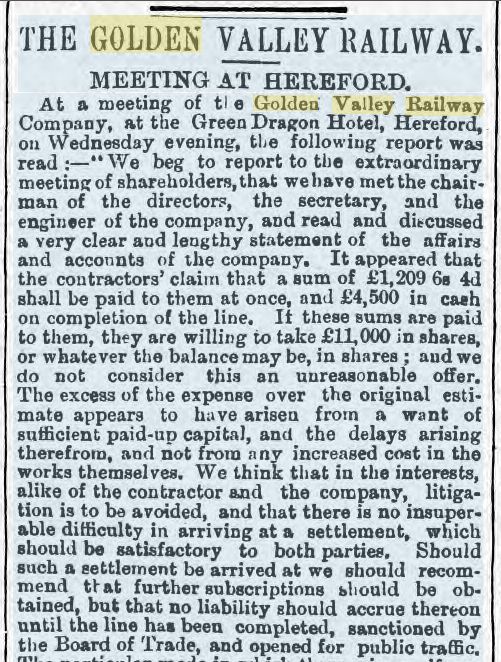

In the event, by 1881 when this first section of the line was completed the cost of the track had risen [mainly, as reported above, through compensating the contractor for late payments because of the Company’s continuing problems raising the necessary finance] to about £3.3 Million, or about £300,000 per mile. The original Hay extension in the Act of 1877 was capitalised at a further £4.8 Million, of which [using the same assumptions as for the original 1876 line to Dorstone] we can presume about half [or £2.4 Million] was budgeted for building the 6 miles or so of track and the attendant stations. The anticipated £400,000 per mile cost was therefore double that originally estimated for the Pontrilas to Dorstone section. This presumably reflected the more difficult terrain from Dorstone to Hay compared to the relatively easy riverside route in the Dore valley for the first section of the railway; the hard lessons of the cost overruns on that earlier section had yet to be learned.
So matters remained for some years while the Golden Valley Railway Company struggled both to complete the railway to Dorstone and to raise the finance for the Hay extension. However, in the background an increasingly acrimonious debate over the future of the railway was taking place. The Hay investors, true to their original objectives, wanted to stick to the planned line to a stand-alone terminus at Cae Mawr as specified in the 1877 Act, built as economically as possible so they could benefit from the Golden Valley trade. A group of the Pontrilas to Dorstone investors, seeing no return on their money to date and fading prospects for future dividends from an independent railway, were pushing to recoup their investments through a deal with the Great Western Railway to take over the line, but the GWR were opposed to an extension to Hay which might benefit the Midland Railway, their competitors. At the same time a strong faction of the Directors of the Golden Valley Railway Company had a strategic vision of creating a direct link to the Midland Railway at Hay. They saw this as opening up commercial opportunities for through traffic which would transform the finances and investment returns of their railway, but at the expense of rerouting the track and abandoning the stand-alone Cae Mawr station terminus.
In 1884 these matters came to a head and by various means, some arguably underhand, the faction favouring the through link got their way. The Golden Valley Railway [Hay Extension] Act of 1884 was passed through Parliament. Clause 4 of the Act authorised the Company to abandon the construction of part of the original Hay extension [including the terminus at Cae Mawr] approved in the 1877 Act and to build instead a new line linked to the Midland Railway’s existing Hereford, Hay and Brecon line to the north of Hay.
|
|
| Clause 4 of the Golden Valley Railway [Hay Extension] Act, 1884
|
Clause 7 of the new Act provided for two railways; “Railway No 1” of approximately 6 miles leading to a field adjacent to the existing Midland Railway line, and “Railway No 2” of about one tenth of a mile from there to connect to the Midland track.
|
|
| Clause 7 of the Golden Valley Railway [Hay Extension] Act, 1884
|
The above extract from the 1884 Act states that the original route of the 1877 Hay extension line was to be followed for approximately two miles from Dorstone to the point where the new Railway No 1 commenced. This places the commencement of the new [1884] line just past Westbrook station, and as the annotated photograph below from Google Earth shows, there is a sharp turn of the line just after the marker for Westbrook as it commences a big loop to the north and across into the Wye valley. Up to this point the 1877 rail track from Dorstone broadly followed the route of the modern B4348 road to Hay. Unsurprisingly, roads tend to follow the easiest routes and it seems logical to suppose that the original 1877 railway would have continued westwards broadly along the path of today’s road and into Cae Mawr south of the town of Hay. It is clear from the photograph that this would have been significantly shorter than the line eventually built. What is perhaps not so obvious is that the northward turn in the 1884 plan cuts across the grain of the land from one river valley to the next, making construction of the new railway also considerably more difficult than would have been the case for the 1877 route.
|
|
| Image from Google Earth, showing the route of the Golden Valley Railway in the 1884 Act. Orange markers show [right to left] the location of Dorstone, Westbrook and Hay stations
|
The field numbers 1 and 3 where the 1884 Act specifies that new railways should terminate are shown on the 1840 Tithe Map of Cusop [below]. Much of the land in this area was in the ownership of the Cornewall family, and the Rev. Sir George Henry Cornewall, Bart., of Moccas Court, was an important investor in the Golden Valley Railway Company. It is probably no coincidence that the route of the new extension required the company to acquire more of his land, since at the time local landowners still cherished hopes that the railway would yield them substantial profits.
|
|
| Tithe Map of part of Cusop, 1840 [note East is to the top]
|
Both the Midland and Golden Valley railways and their junction appear as ‘dismantled railways’ on large scale ordnance survey maps of the area [see below], and can also still be seen on other modern sources such as satellite images from Google Earth. The small island in the river Wye shown at the bottom of the tithe map is a useful marker for finding the location of the railway junction on other plans and maps.
|
|
| Extract from Ordnance Survey, showing the junction of the Golden Valley and Midland Railways. Reproduced by permission of Ordnance Survey on behalf of HMSO. © Crown Copyright. All rights reserved.
|
The death knell for the railway terminus at Cae Mawr and the essential purpose of the revision to the Hay extension are encapsulated in clause 26 of the 1884 Act, which spells out the entitlement of the Golden Valley Railway Company to use the Midland Railway Company’s station and facilities at Hay. This created the through route that was intended to be the commercial salvation of the Golden Valley Railway.
|
|
| Clause 26 of the Golden Valley Railway [Hay Extension] Act, 1884
|
The Cae Mawr terminus of the Golden Valley Railway thus faded into history with the passing of the 1884 Act.
The consequences of abandoning the Cae Mawr terminus
The first major consequence of abandoning the 1877 Hay extension route was a crisis of investor confidence. As noted above, the original line planned from Dorstone to Cae Mawr was about 6 miles long at a budgeted construction cost of about £2.4 Million, or £400,000 per mile, already twice the original budget for the earlier Pontrilas to Dorstone section. The new 1884 route to Hay was about 8 miles in total [including 2 miles of the original 1877 route]. However, although it was only two miles longer, the contract for its construction was awarded to Charles Chambers of Kington for a price of about £7.7 Million, or very nearly £1 Million per mile. Despite the best efforts at “creative accounting” by the directors, where a substantial part of the payments for the construction were to be made in shares and debentures rather than cash, these costs could not be disguised for long. Existing investors quickly realised that at nearly five times the cost per mile that they had originally bought into for the Pontrilas to Dorstone venture, this was no longer the cheap light railway of the share prospectus and the economic case laid out in that document for a good return on their investment no longer looked credible. This in turn led to accusations of fraud and to related litigation that would plague the Golden Valley Railway Company for many years.
Potentially even more serious, the entire additional capital of the Railway Company authorised in both the 1877 and 1884 Hay Extension Acts had been committed by the Directors to construction of the line, apparently without consideration of the need for additional rolling stock, other assets and increased working capital to operate the extended railway once built. In the event this was to prove the downfall of the entire business, as the hoped-for increases in revenues from through traffic proved insufficient to meet the operating costs of the railway, let alone satisfy the investors’ demands for a return on their capital. Despite various other schemes and the best endeavours of the management, the Golden Valley Railway Company gradually slid into bankruptcy. It was liquidated in 1899 and the track and other assets were purchased for a pittance by the Great Western Railway.
Conclusion
Would the outcome for the Golden Valley Railway Company have been different if the original line to Cae Mawr had been built? It is impossible to say with certainty. However, the economic case for the entire Golden Valley venture right from the outset had been based on the concept of a low-cost, no frills light railway. The 1877 extension to Cae Mawr, although more costly than the Pontrilas to Dorstone section, was still broadly consistent with that underlying philosophy. It is therefore tempting to think that if the Directors had not been carried away with more grandiose ambitions the Golden Valley Railway Company might have become a modest success and endured for longer, saving local investors much loss and grief in the process.
Perhaps after all the Hay terminus at Cae Mawr deserves to be remembered as “the station that should have been” rather than “the station that never was.”
Ref: rs_gdv_0058

